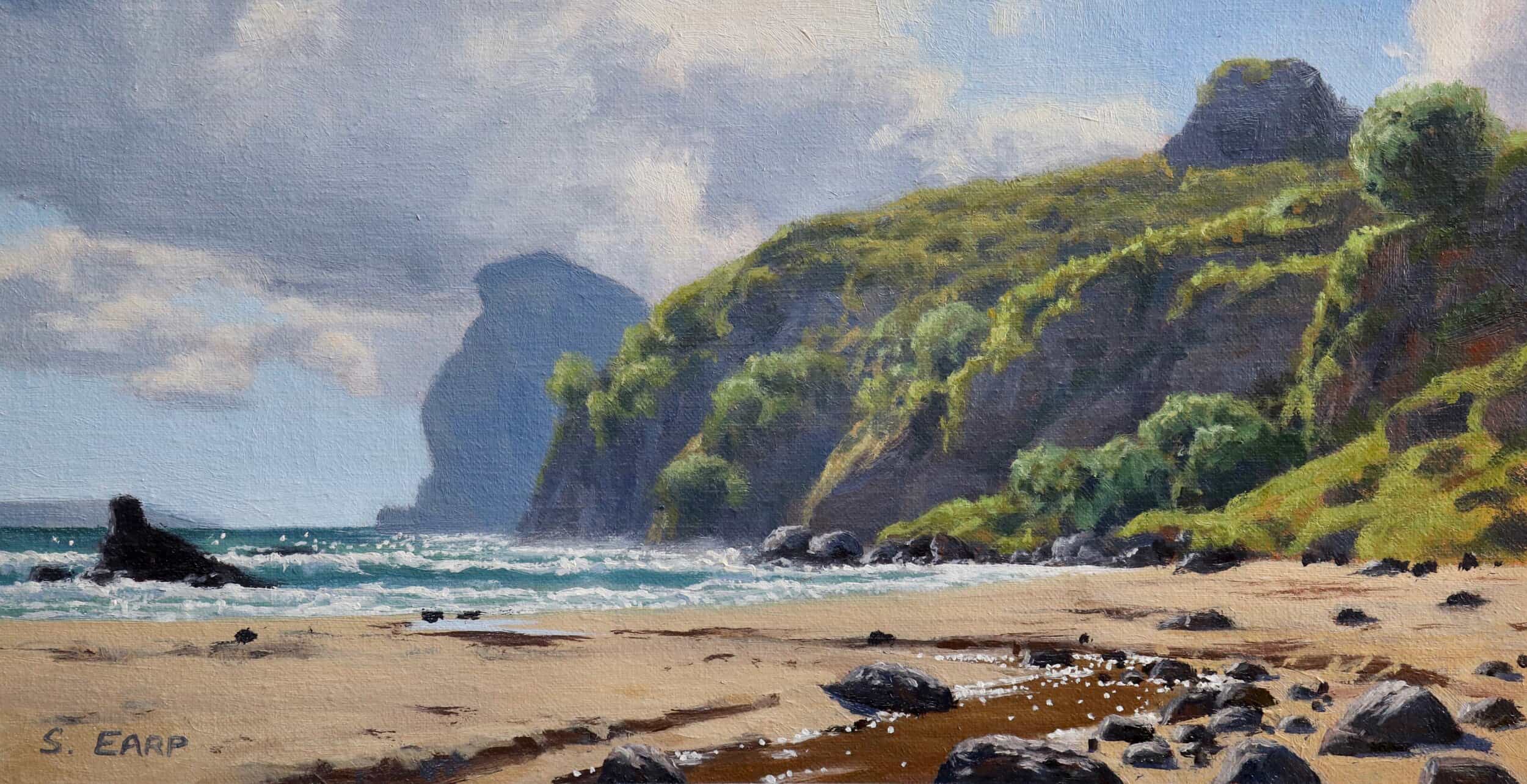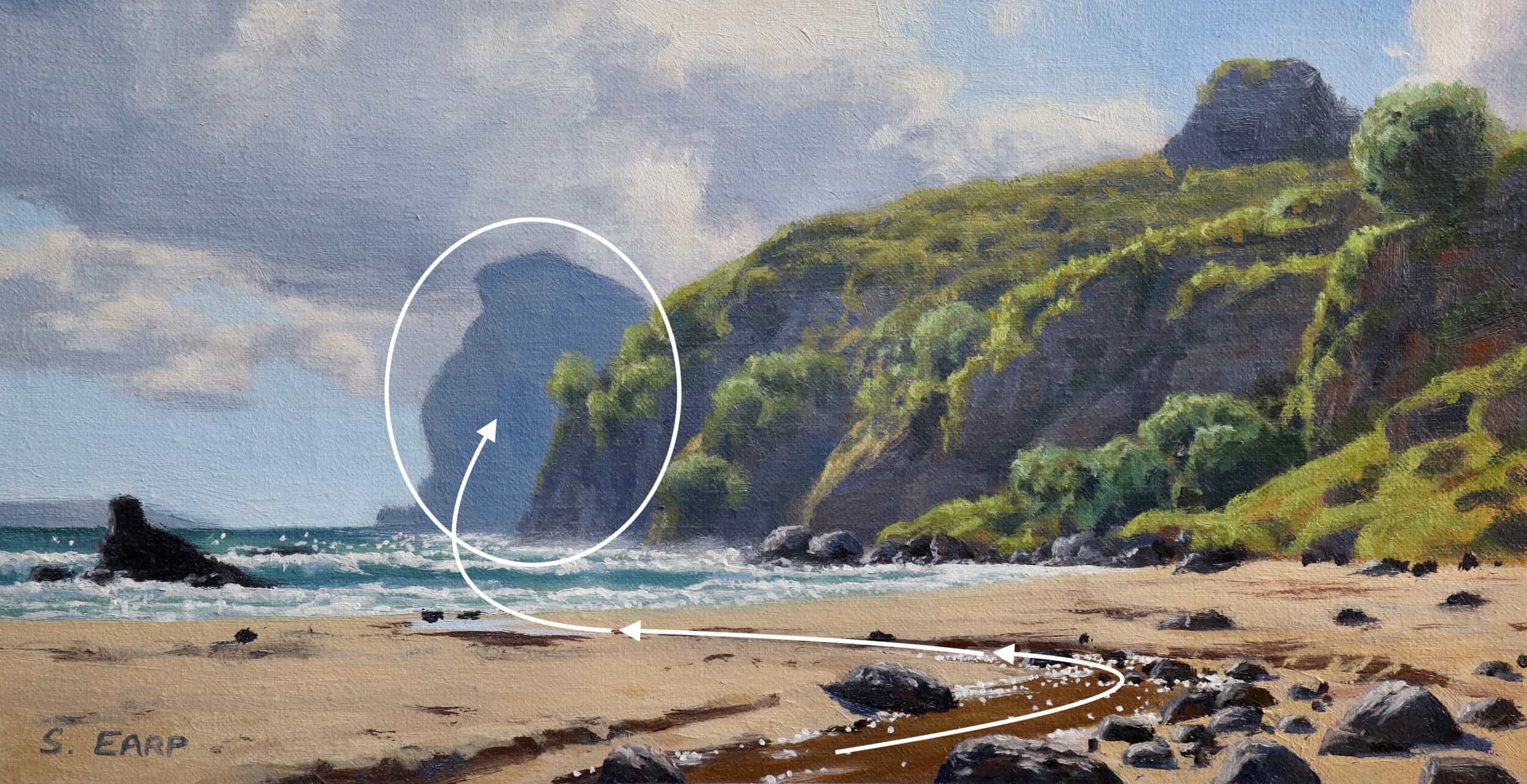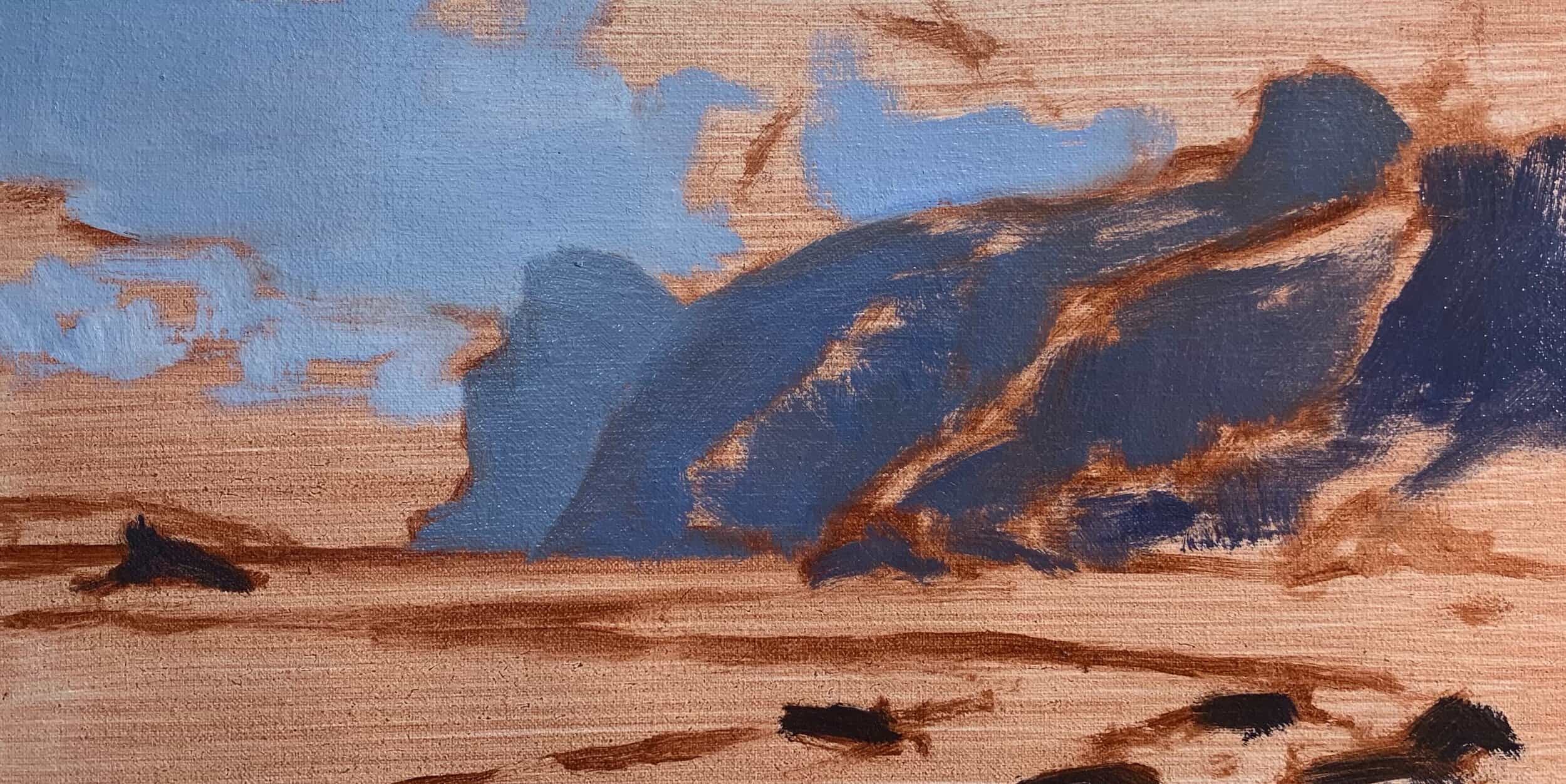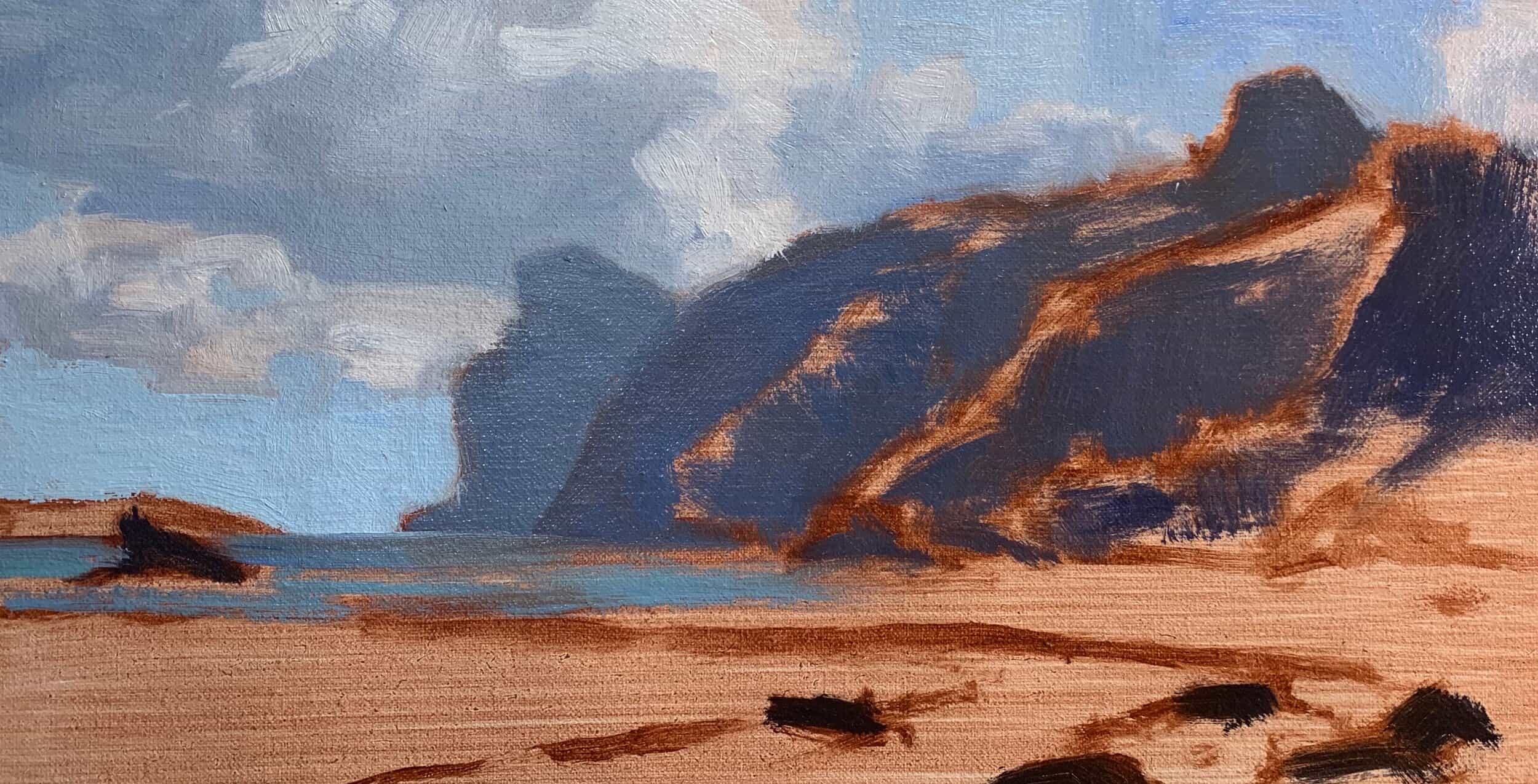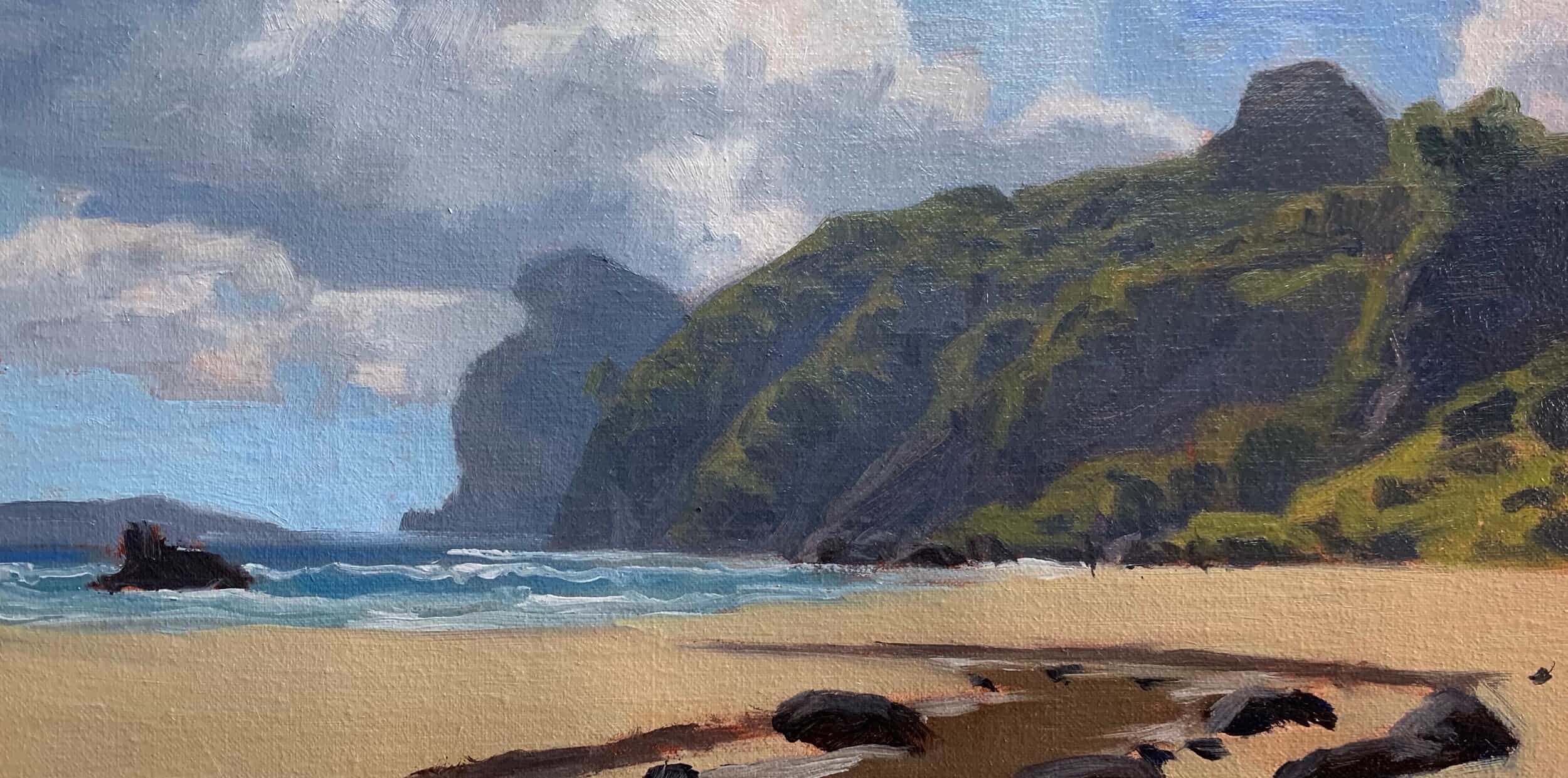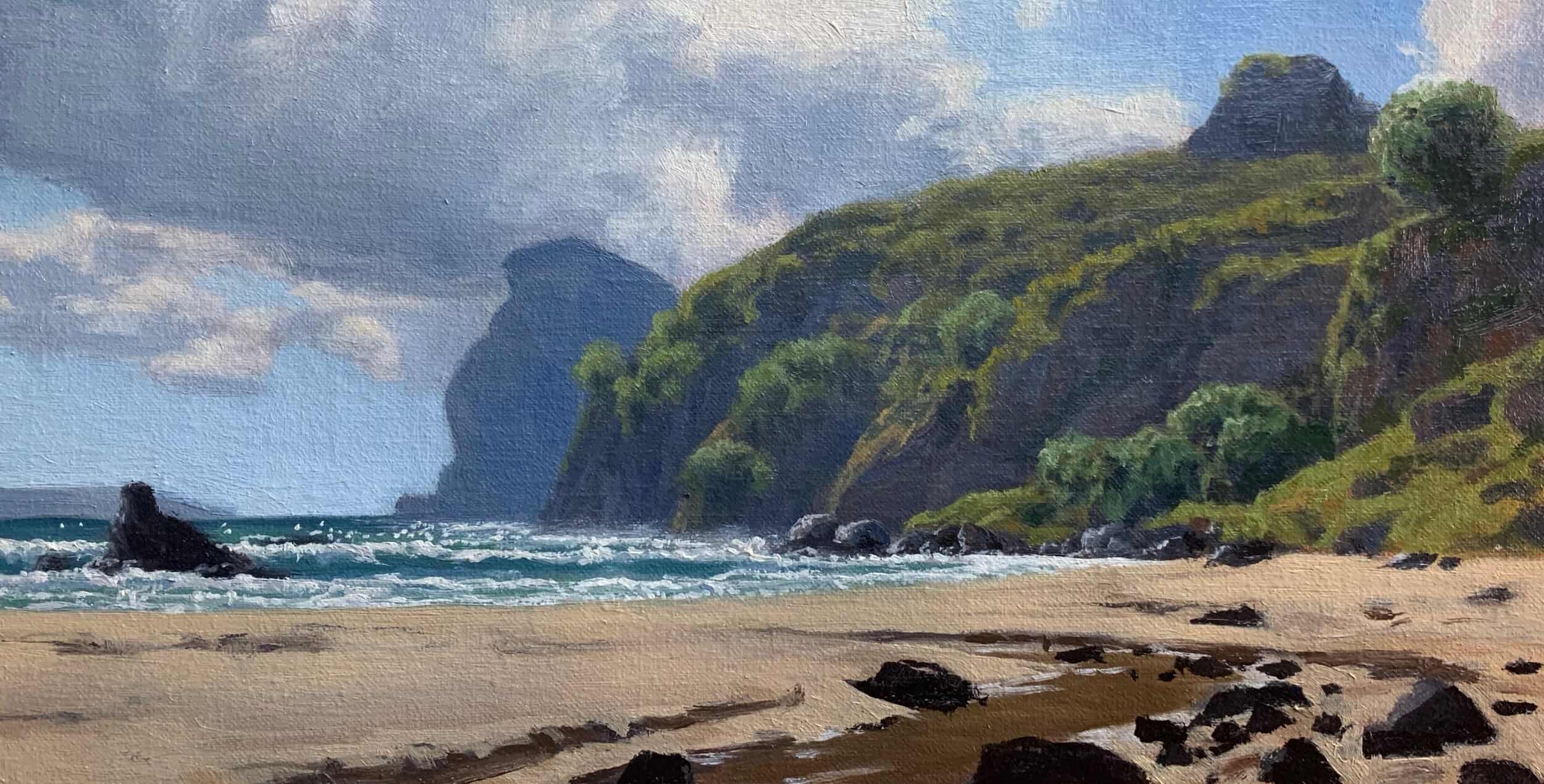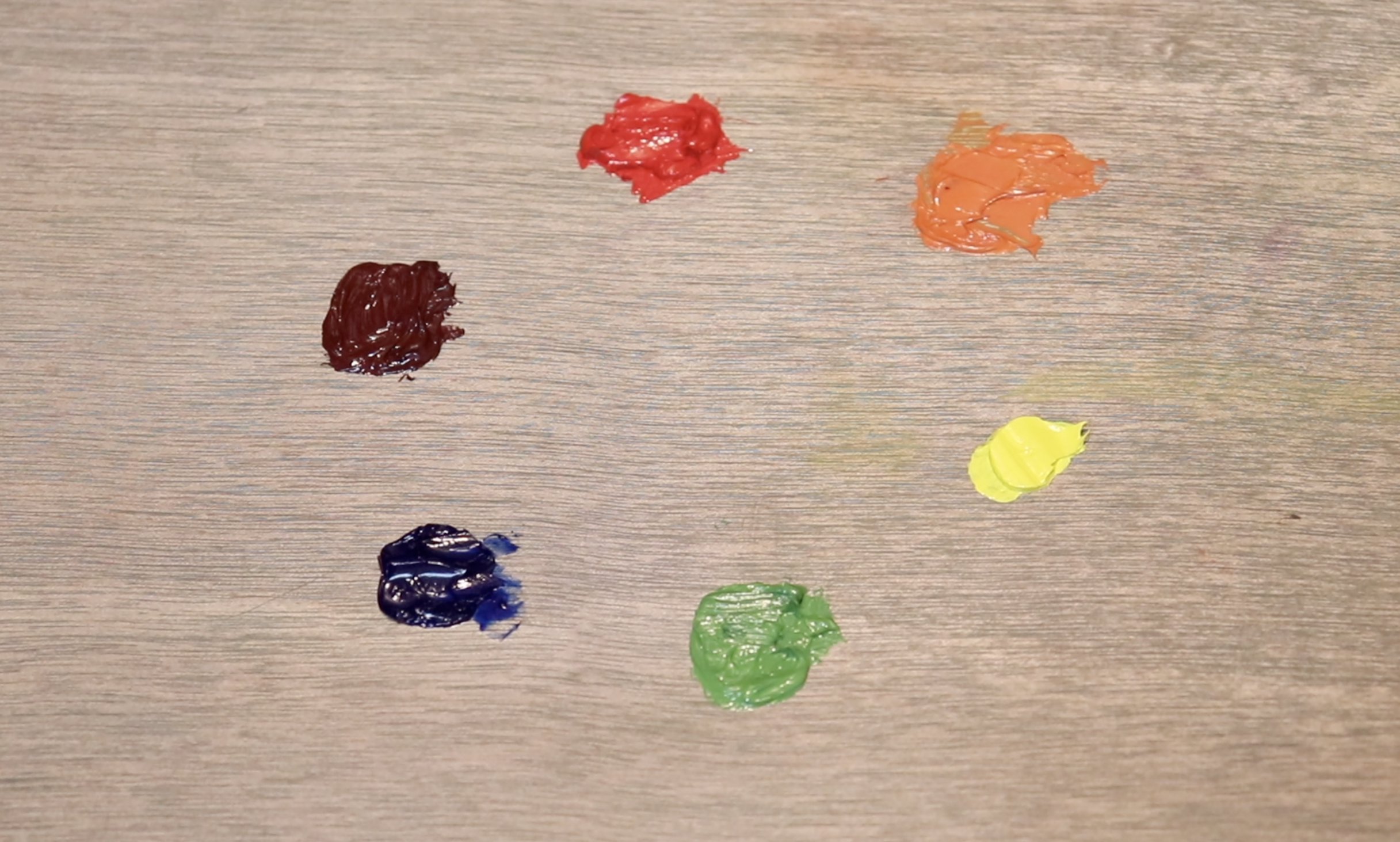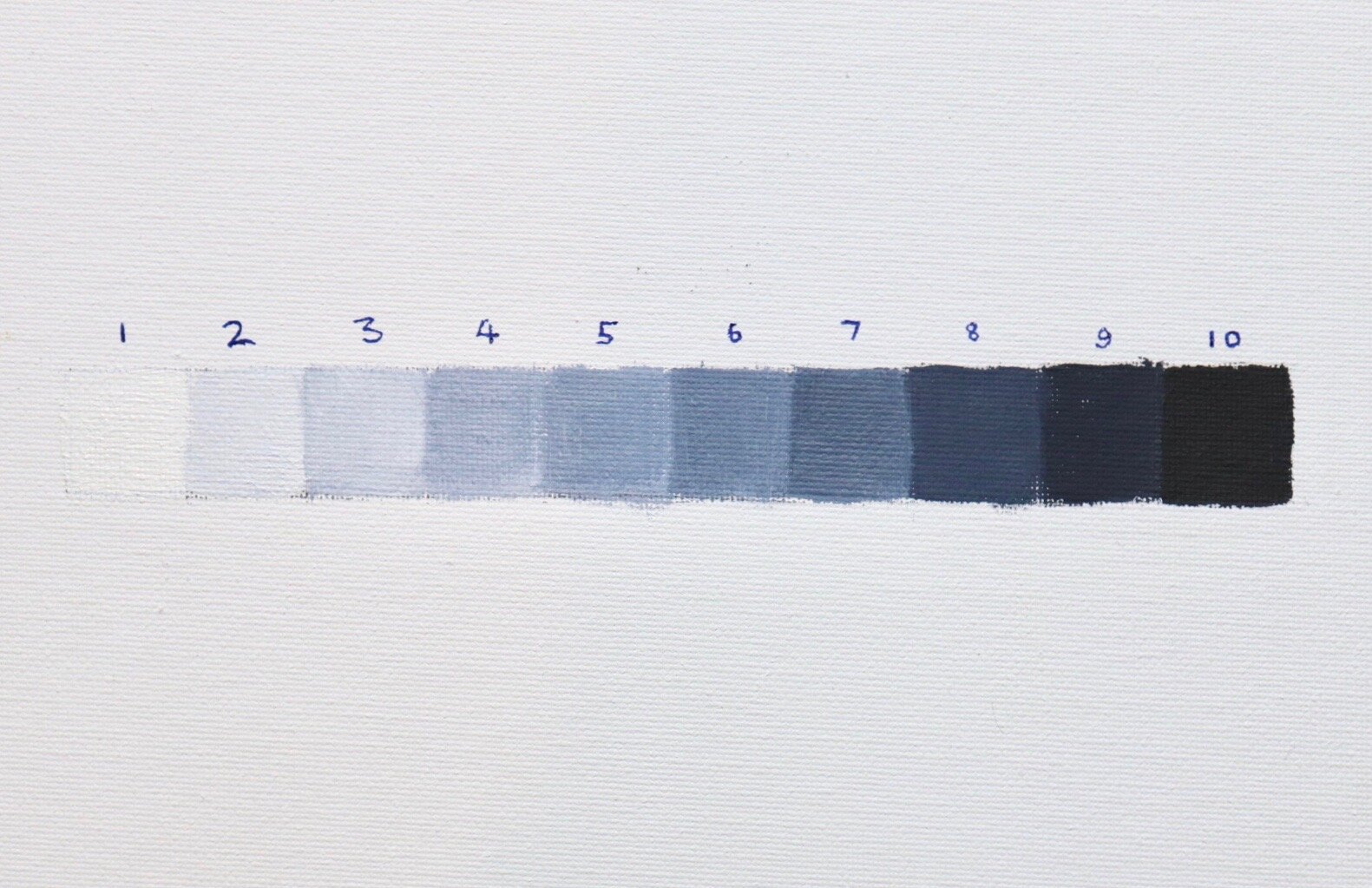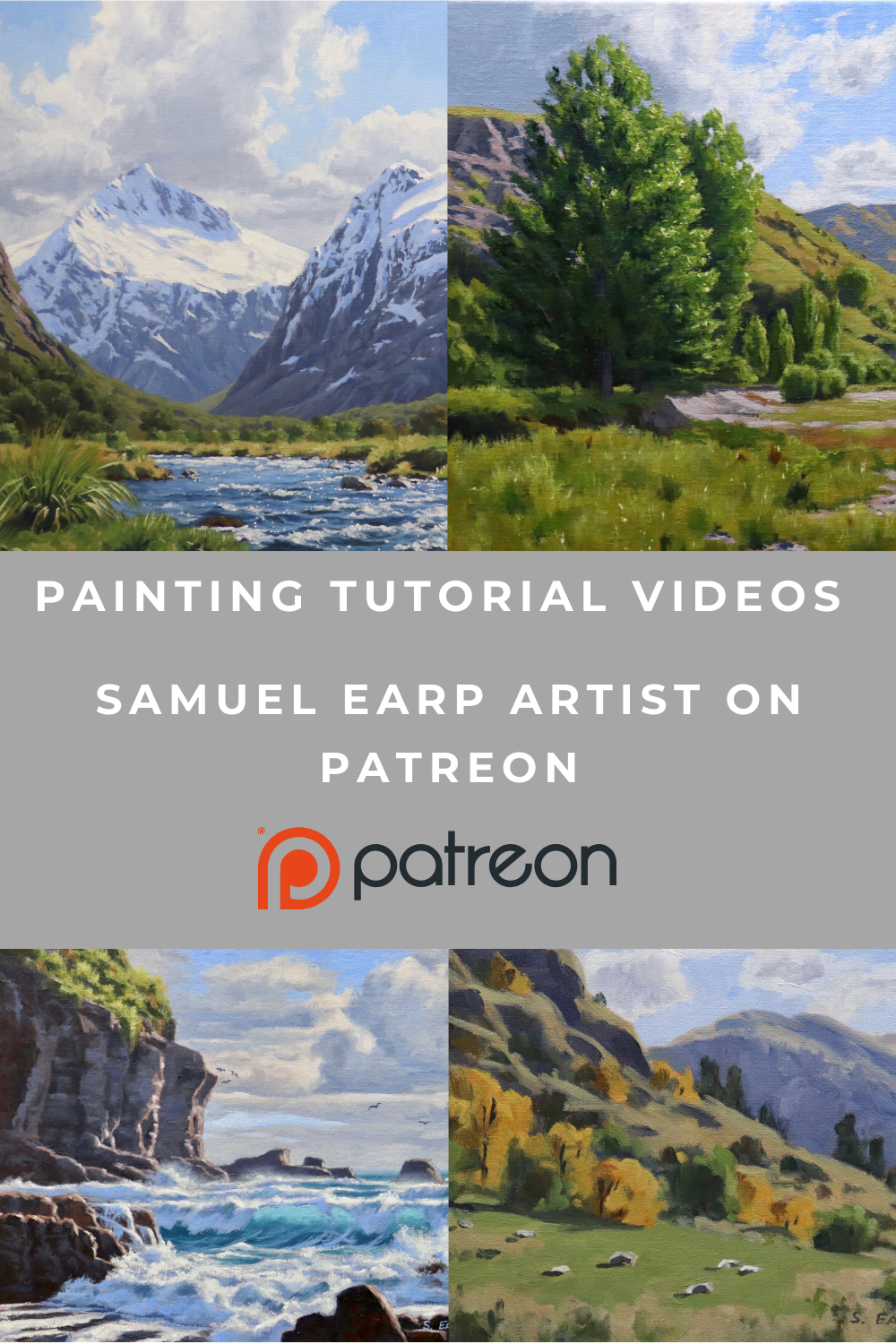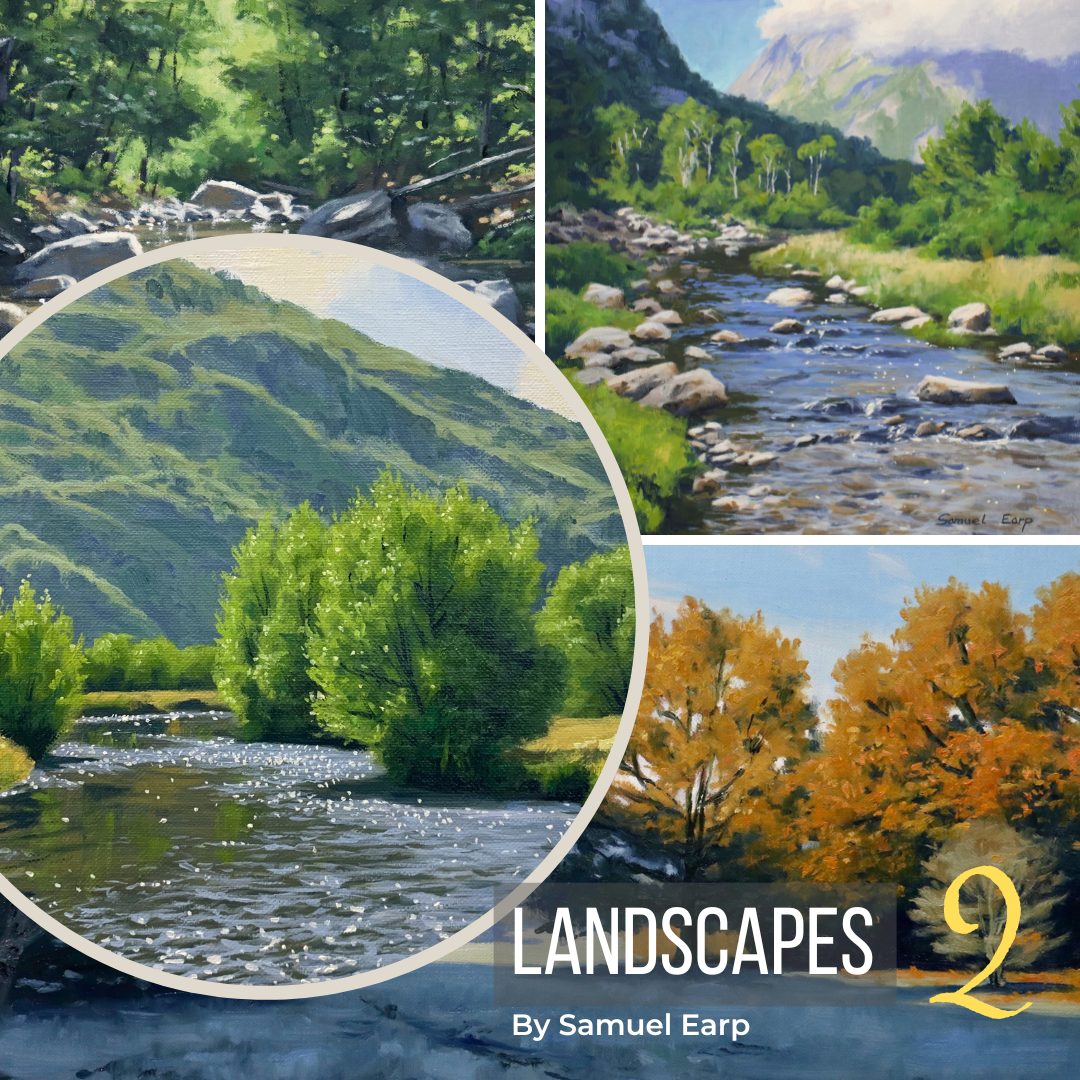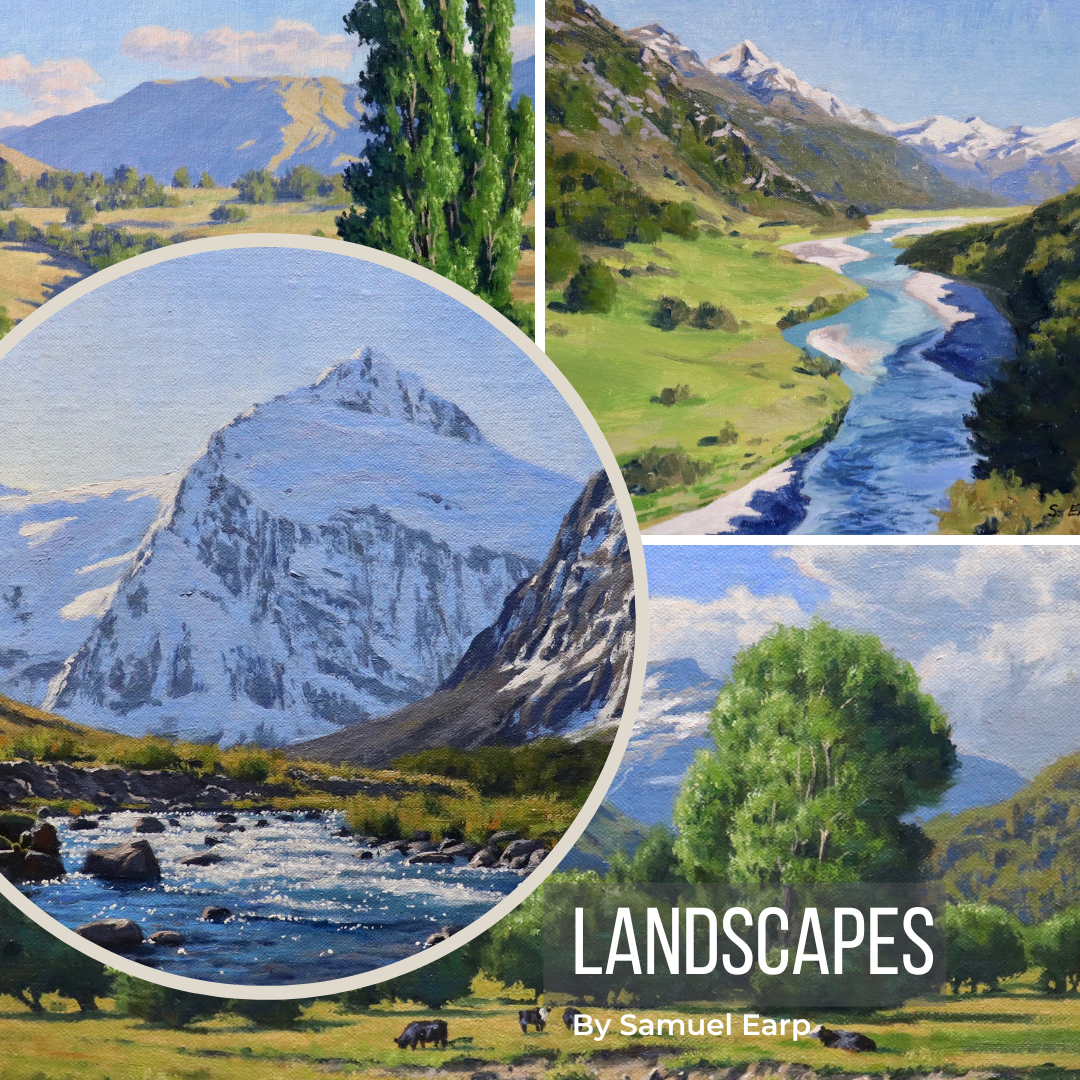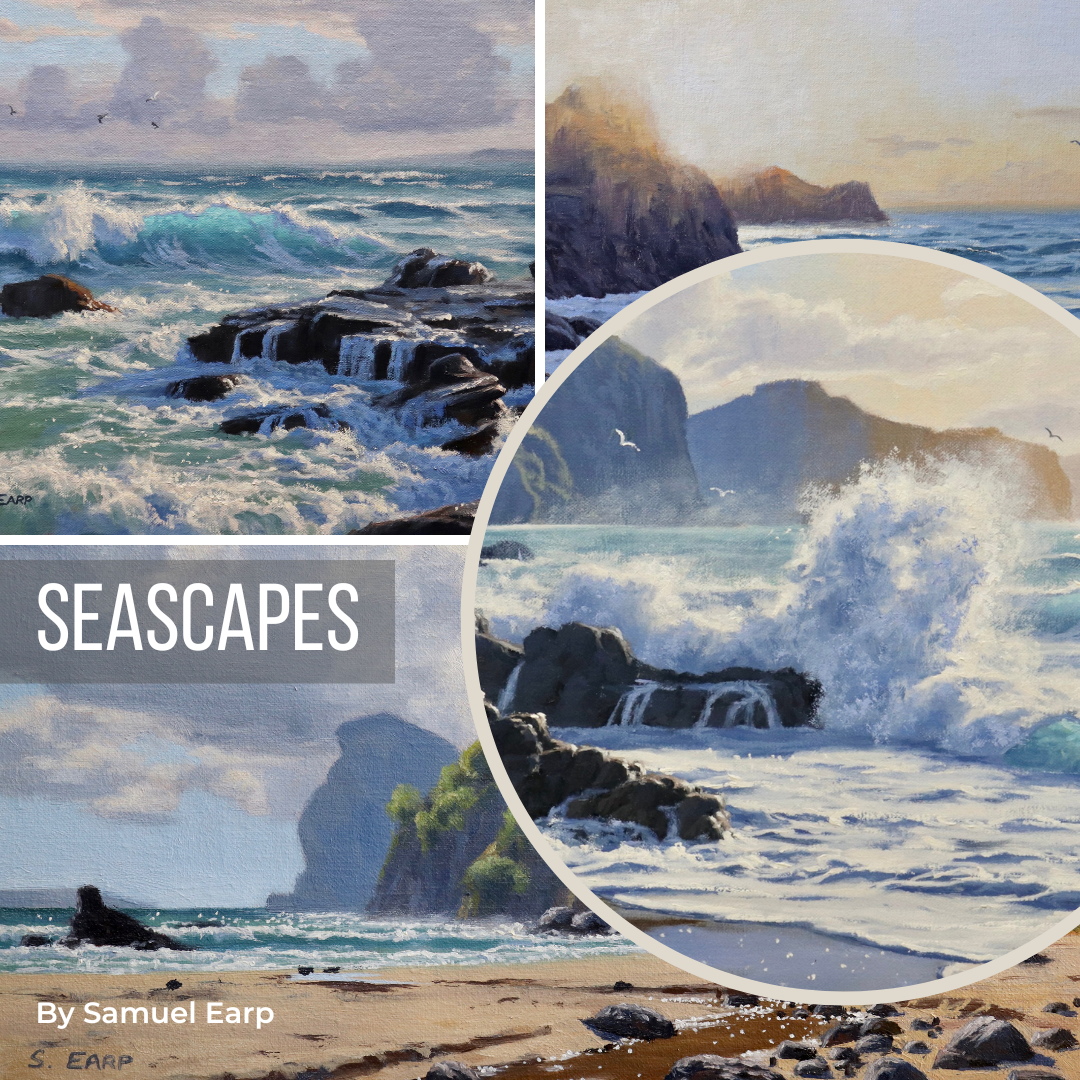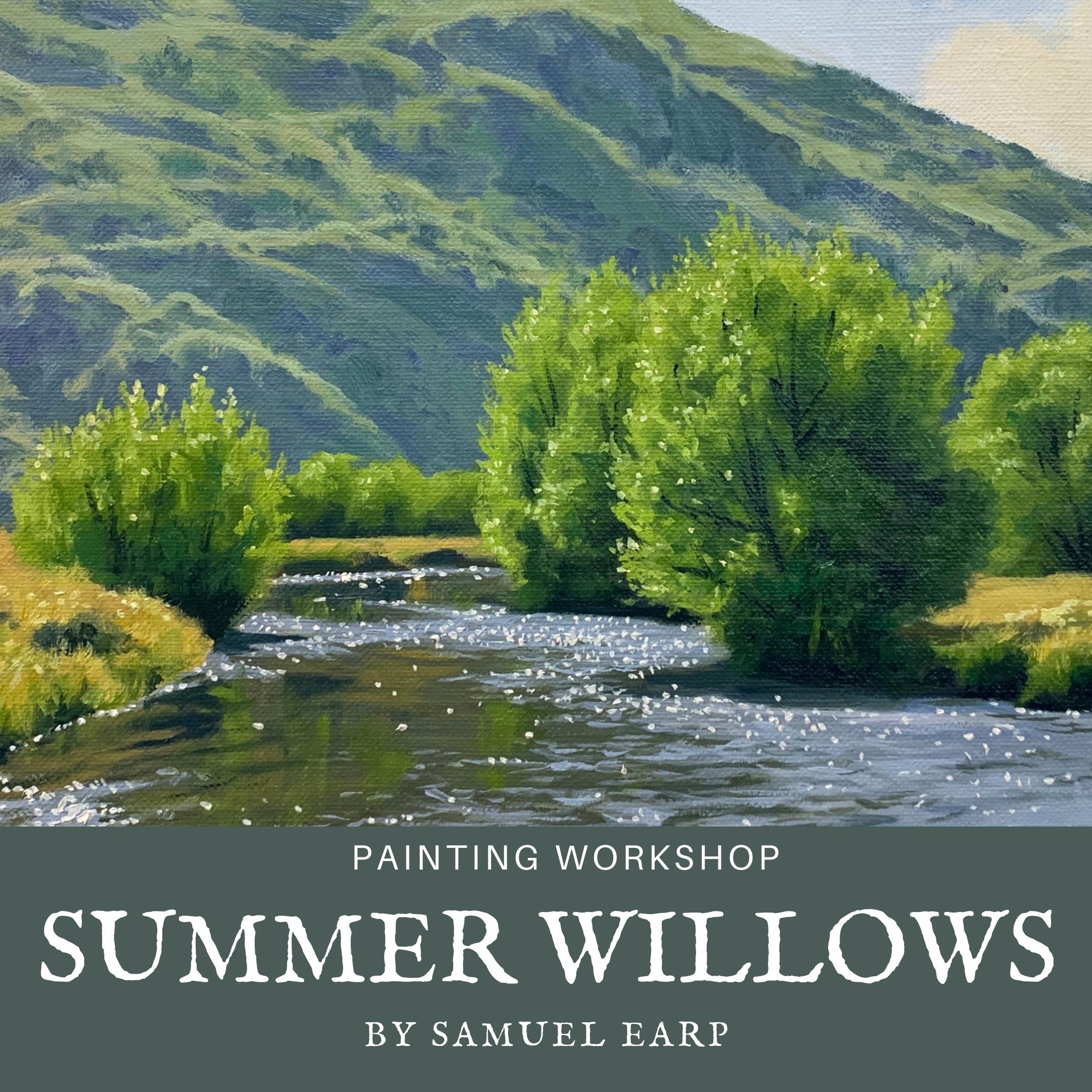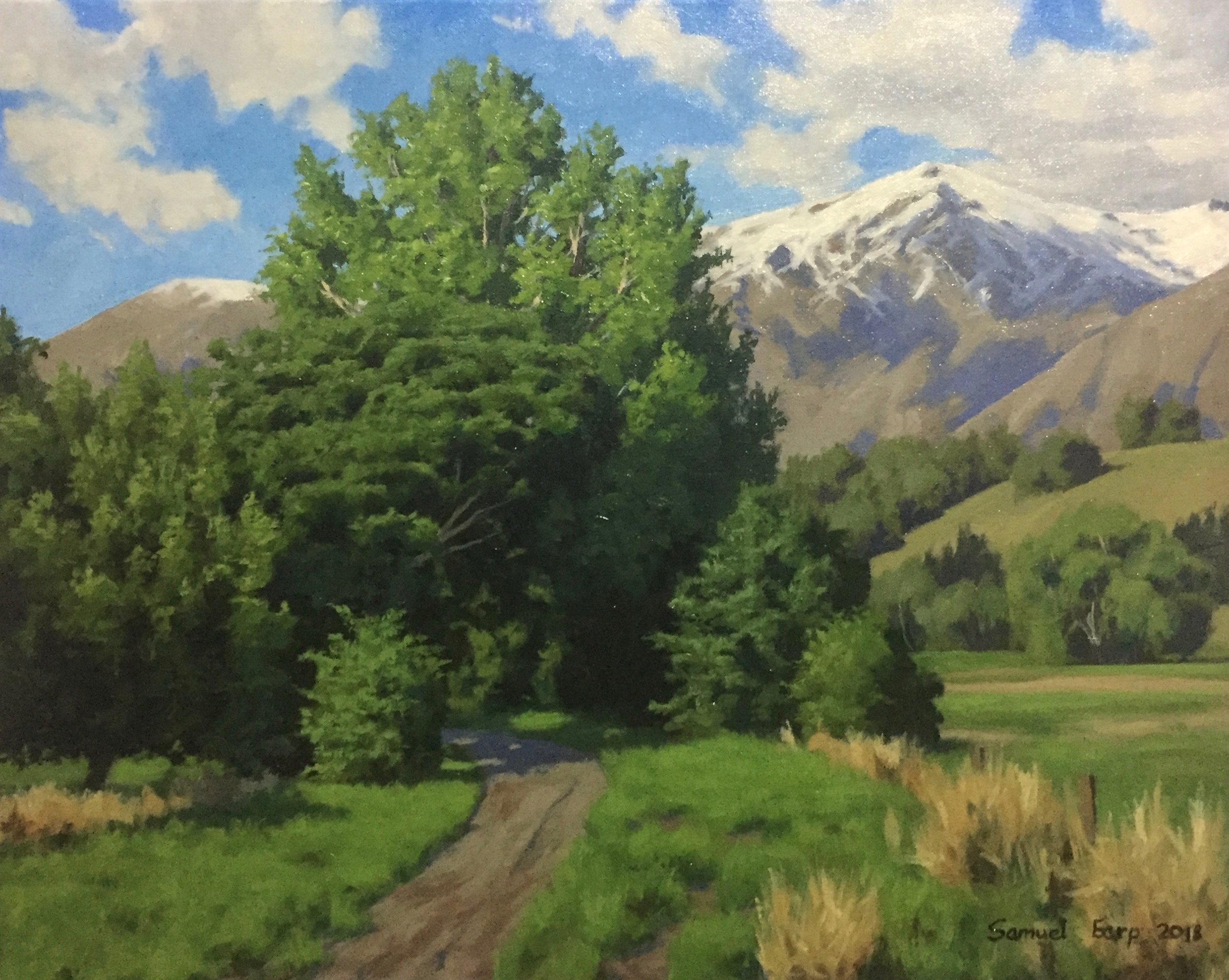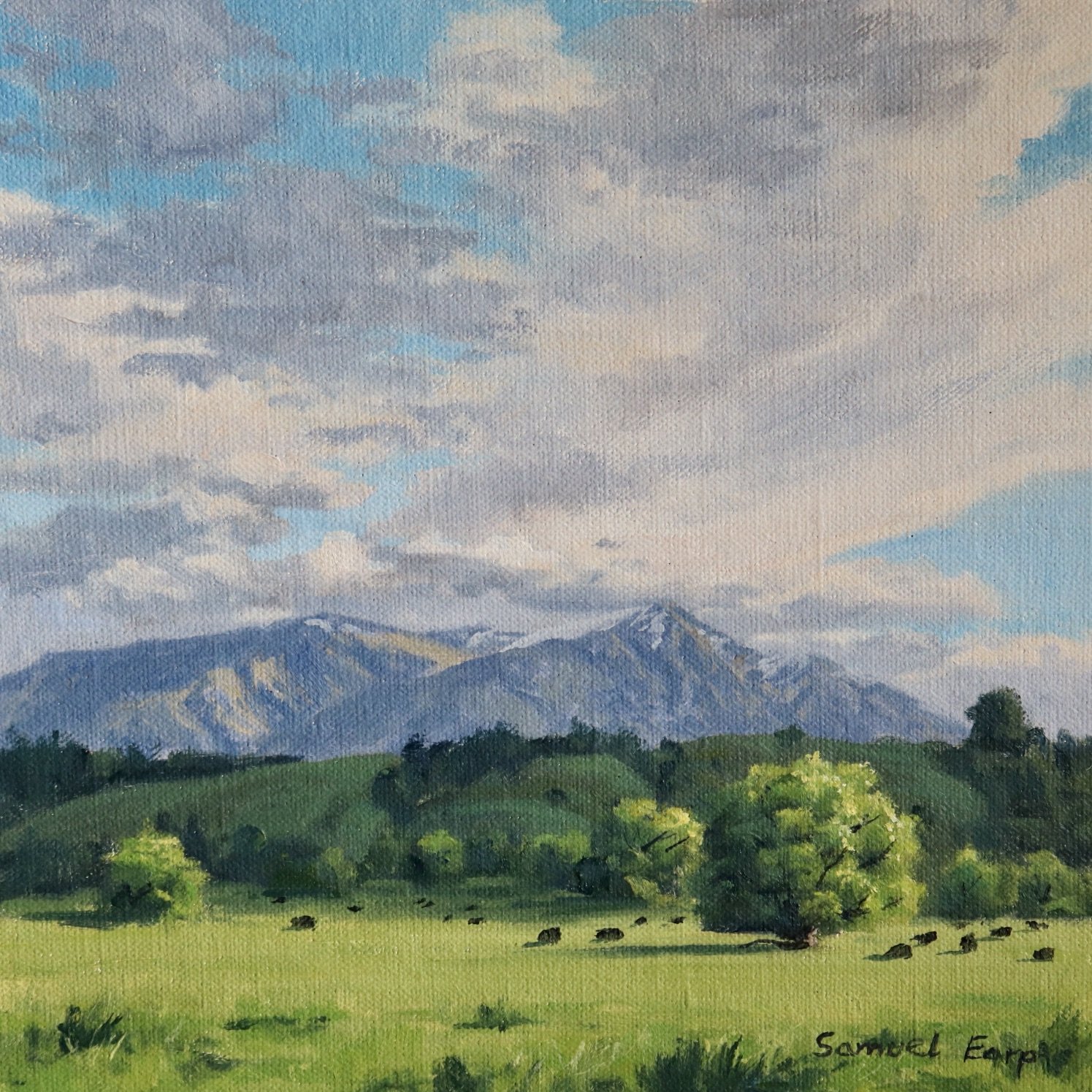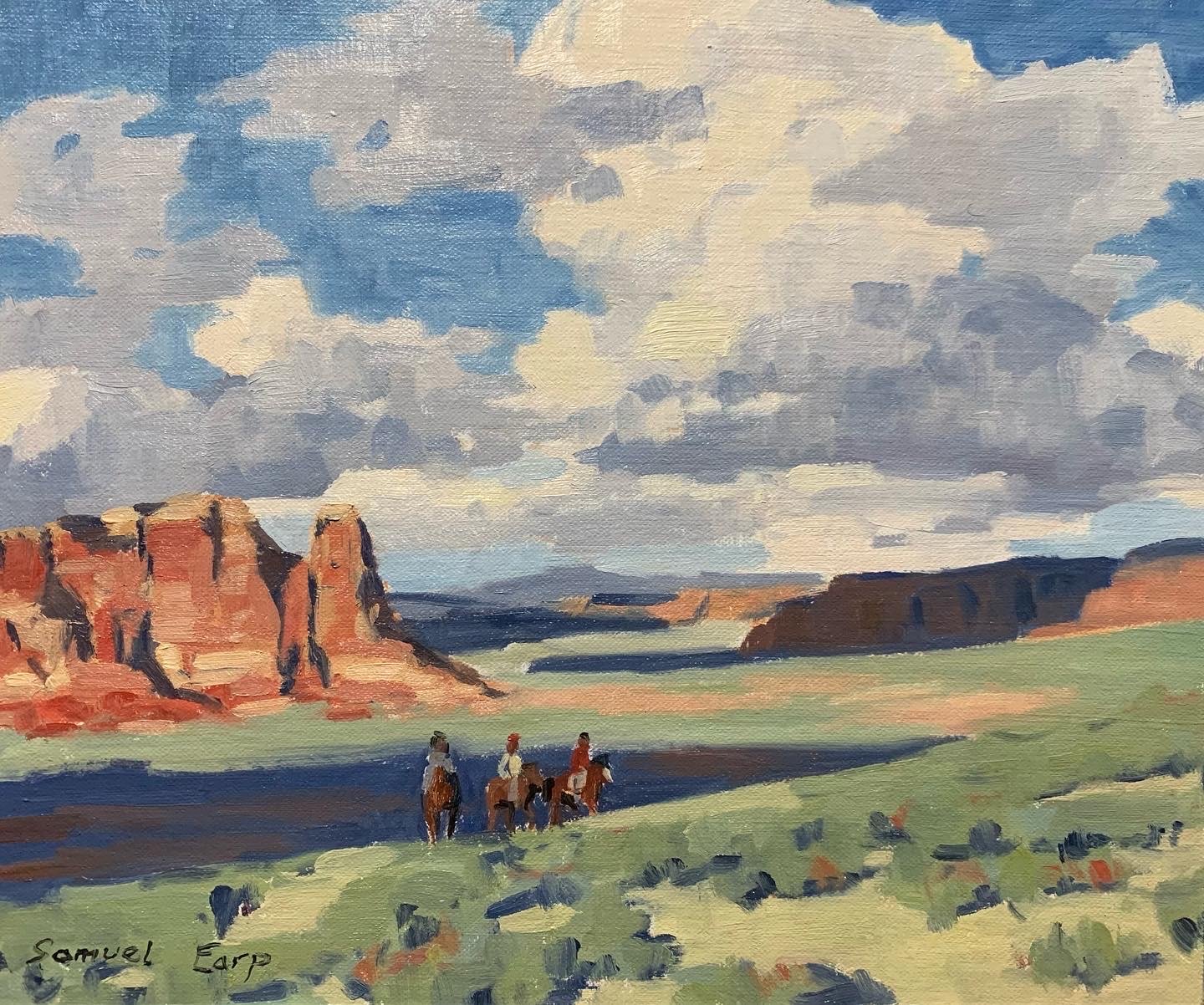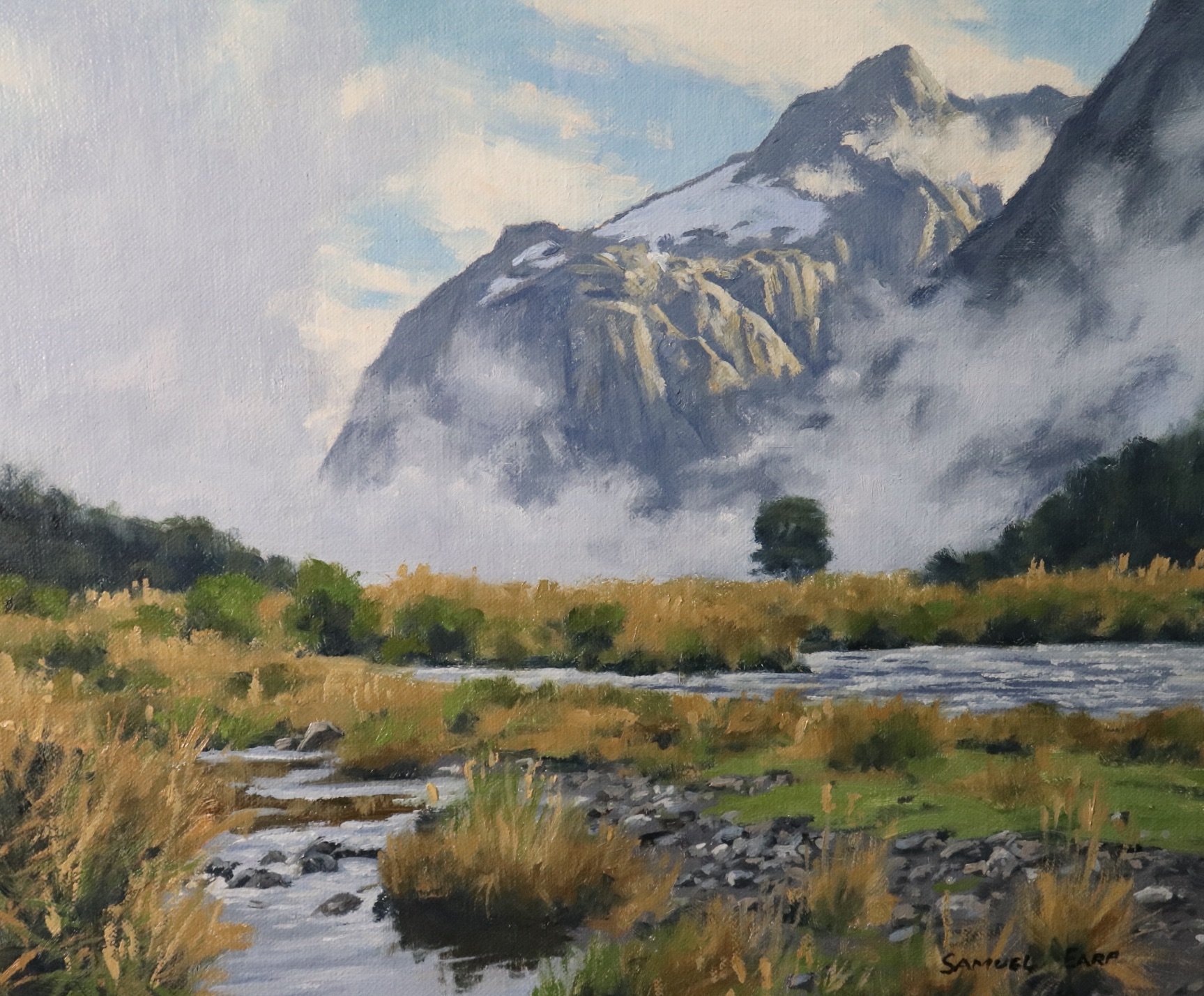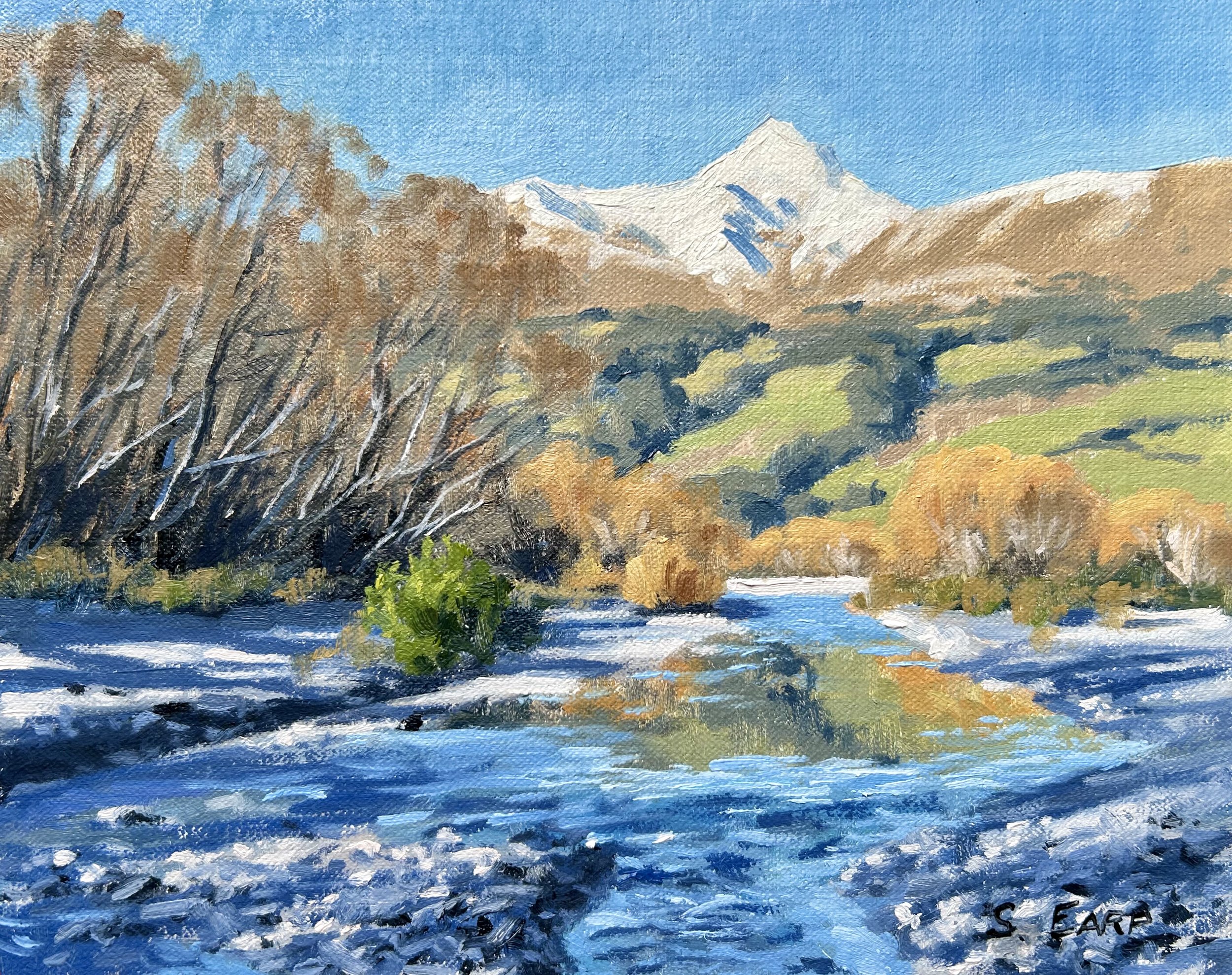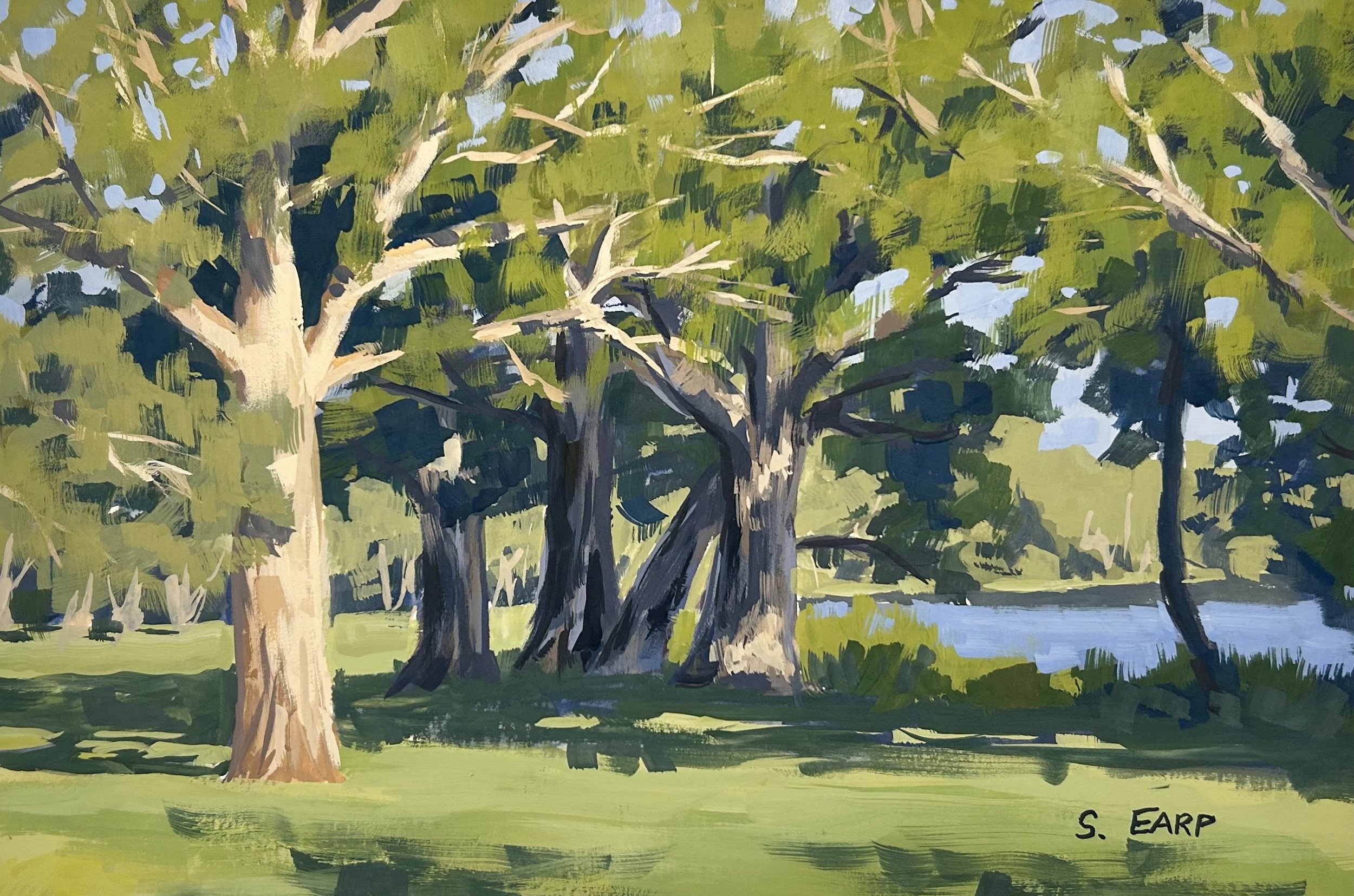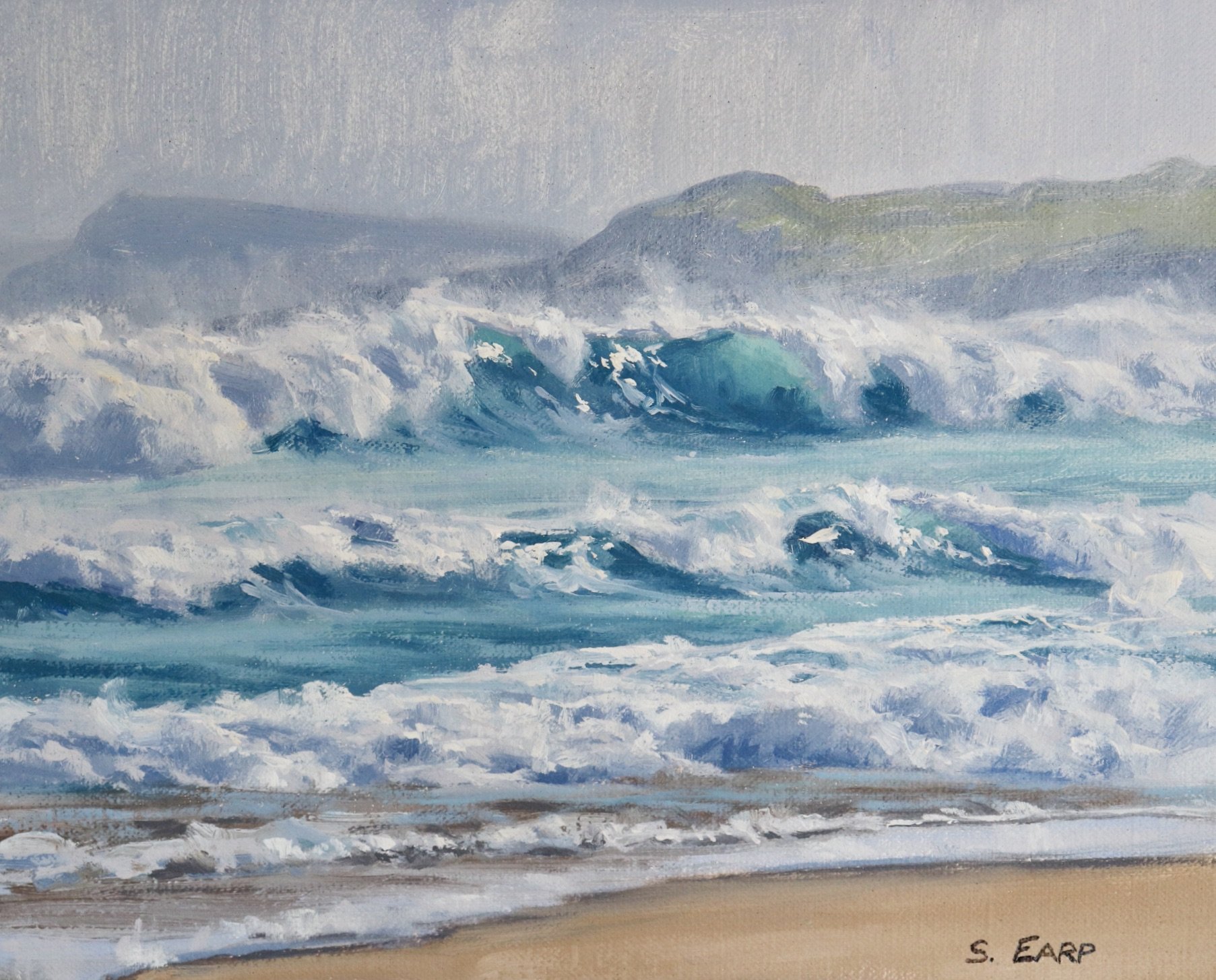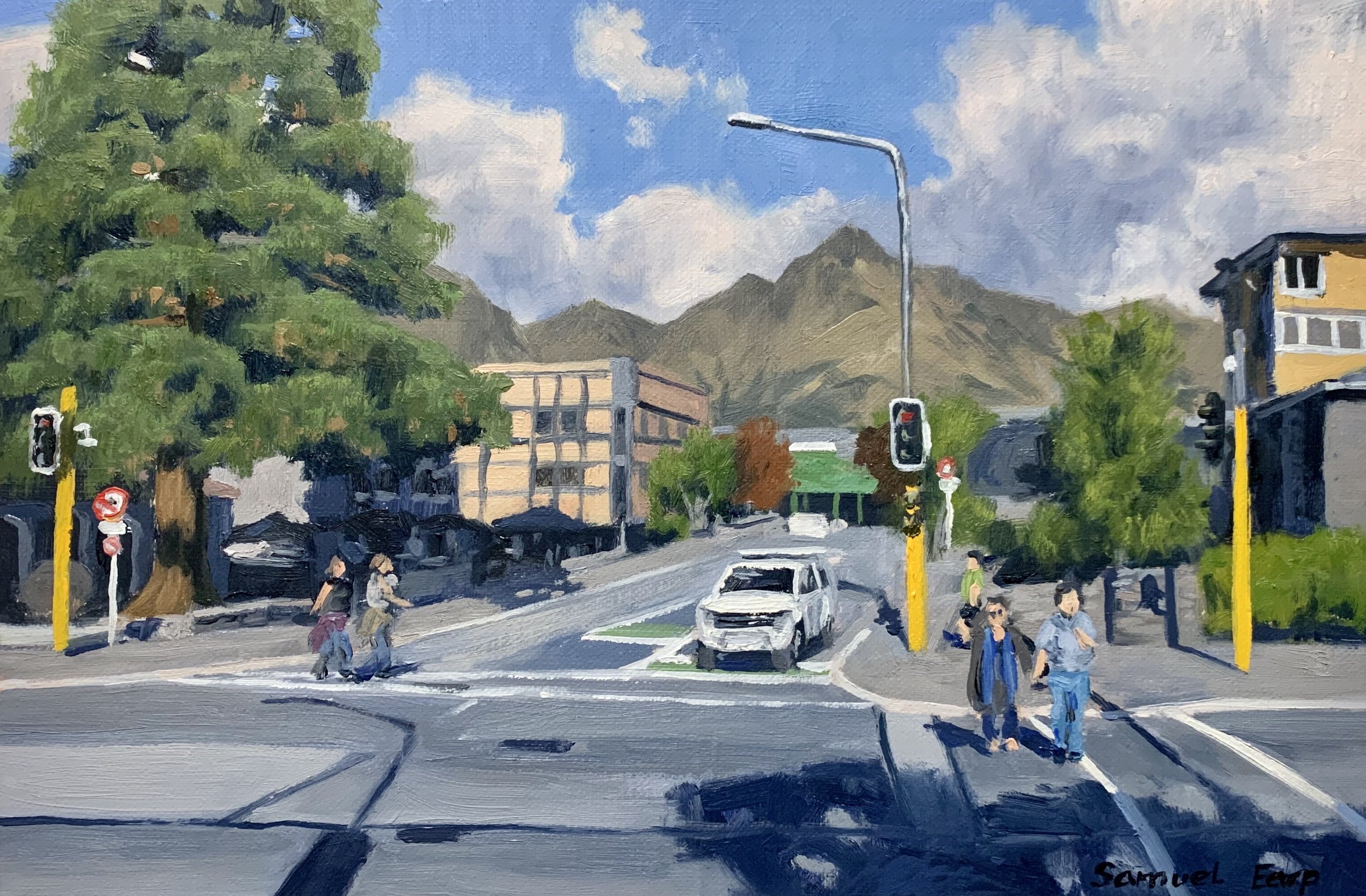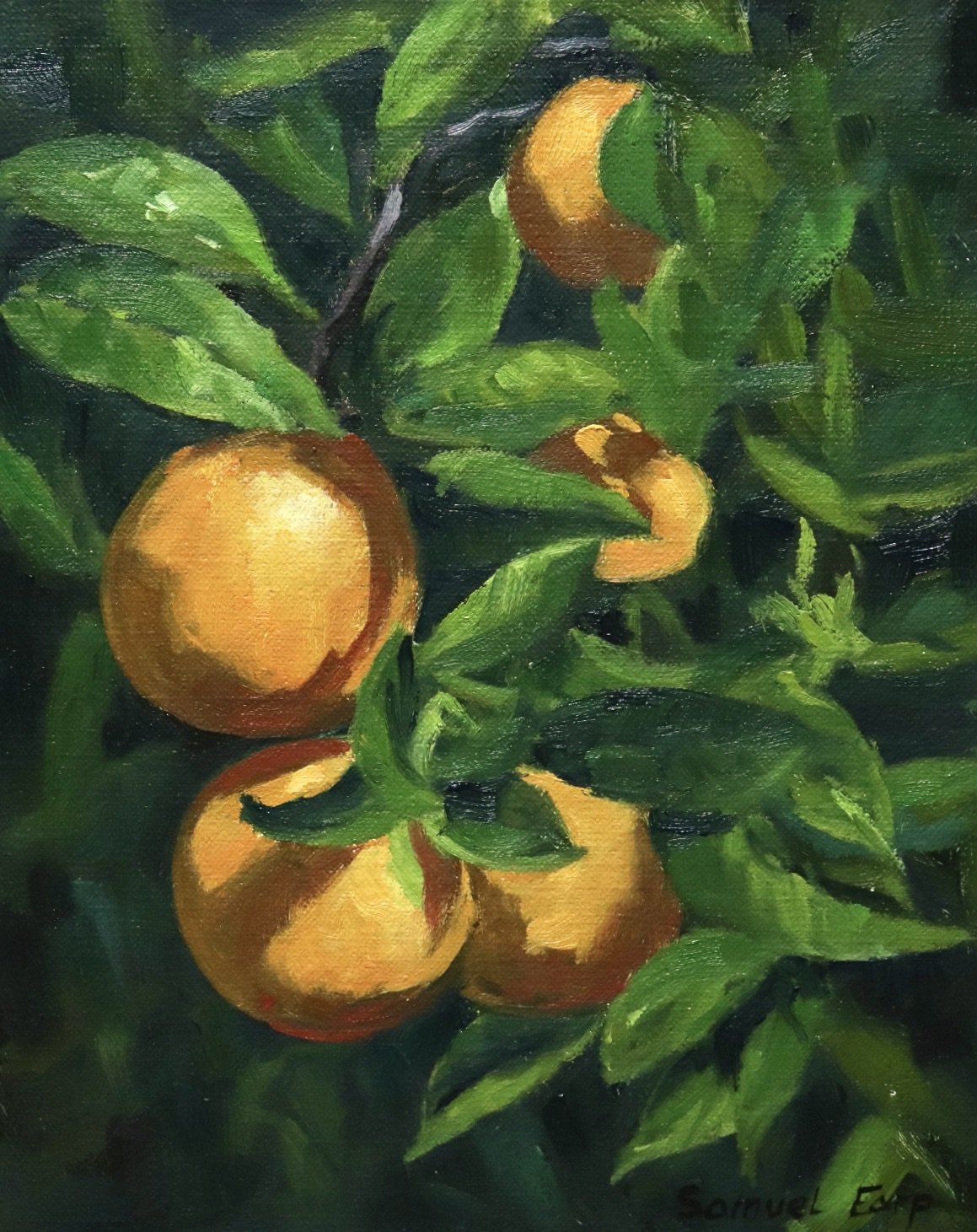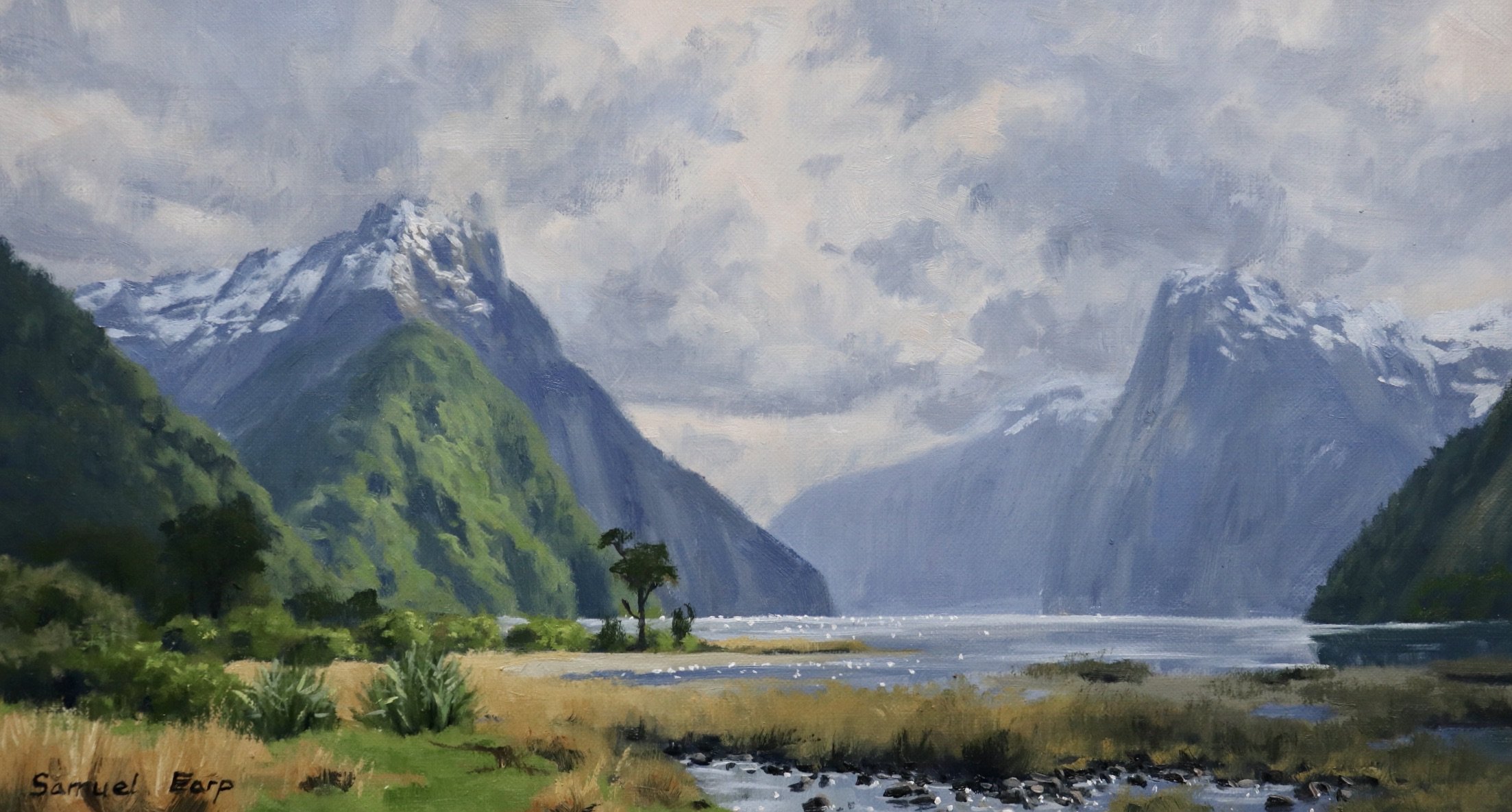Painting Workshop No.5 – Lesson Notes
Taupo Bay
By Samuel Earp
These lesson notes are intended for use with the ‘Taupo Bay’ painting tutorial video. If you stumbled across this page you can purchase the video by clicking the link below:
Reference Photos
Please feel free to use the reference photos provided.
Composition
This painting incorporates an ‘S’ composition.
The ‘S’ composition is a simple and very useful composition to incorporate into your painting. This type of composition helps to add a sense of rhythm to your painting.
In this case the stream leads the eye towards the sea and headland which is the main focal area in the composition.
Planning Your Painting
Before you get into a painting I would always recommend doing some pencil sketches to plan your composition. A painting is much more likely to be a success if it has a solid foundation.
When you have an idea for a painting, start designing the composition by doing a few quick thumbnail sketches in your sketch book. Spend around two to three minutes on each sketch.
Once you have done a few thumbnail sketches and have a good idea of your painting design you can then complete a final pencil sketch. The pencil sketch will help you finalise the composition and give you a good idea of the tonality of the subject you are painting.
I completed this drawing on grey paper. The darker value of the paper creates an impact when I sketch the highlights in the clouds, sea, cliffs and stream. I used a white pastel pencil for the highlights
I use a range of pencils when sketching, including a 4H, 2H, HB, 2B, 4B, 6B and 8B. I have also used a white pastel pencil for the highlights.
The pencil sketch will be the foundation for your painting which should help you in creating a pleasing composition.
Colours Used in This Painting
I painted this art work in oils but you can also use acrylics. the colours I used includes:
-
Titanium white
-
Burnt sienna
-
Yellow oxide
-
Cadmium yellow
-
Cadmium orange
-
Quinacridone magenta
-
Ultramarine blue
-
Cobalt blue
-
Cobalt teal
-
Phthalo green
Brushes
Below is a general list of brushes I use for landscape paintings
-
No.6 flat
-
No.4 flat
-
No.2 flat
-
No.2 filbert
-
No.1 round
-
No.0 round
-
1/4″ dagger
-
3/8″ dagger
Blocking-in the Painting
I am painting on a piece of loose linen which measure 6″ x 12″, which I have taped to a board. I’ve toned the linen with a layer of burnt sienna. This really helps with overall colour and tone of the painting and gives the art work a more traditional feel.
I sketch out my composition with a No.1 round brush and burnt sienna. I am using the medium Liquin Original for this painting, which thins out the paint and speeds up the drying time.
Paint Your Darks First
Whenever I begin blocking in a painting I normally start by establishing my dark values and shadows first, that way I can quickly establish the tonal range in the painting. It also then makes it much easier when you come to add the areas in light as well as getting the saturation of your colours correct.
Whenever I begin a painting I try and establish the tonal dynamic first as it makes it easier to paint the areas in light afterwards. The easiest way to do this is to paint you dark values and shadows first.
I start with the cloud shadows and whilst the clouds are tonally much lighter than the rest of the shadows, it is still a shadow. I therefore I include the cloud shadows with the rest of my dark values in the painting.
For the cloud shadows I have used a mixture of ultramarine blue, burnt sienna and titanium white. The burnt sienna being a dark orange desaturates the blue. I can make the value lighter by mixing in titanium white.
For the headland (the main focal area of the painting) I have used the same colours as I used in the clouds but with much less titanium white.
As I paint the rest of the cliff shadows I am still using the same colour combination but this time I introduce a little quinacridone magenta into the mix which gives the colour a violet tint. This adds another layer of depth the colour.
My darkest shadows are in the foreground which I reserve for the rock shadows. This is a simple combination of ultramarine blue and burnt sienna.
Now I have established my dark values it’s time to start applying some colour to this painting. I start with the background first and work forward.
The sky is the furthest zone away in the painting so I start with this. I paint the highlights of the clouds with a No.6 flat brush using titanium white mixed with a little burnt sienna. I also allow this to mix in with the cloud shadows I have just painted.
I paint the sky with a combination of ultramarine blue, cobalt teal and titanium white.
I begin painting the sea, marking in where the main body of the ocean and the breaking waves are going to sit within this zone.
I mix a combination of ultramarine blue, cobalt teal, yellow oxide and titanium white. I vary the amount of individual colours that I am using to create different sea tones, for example for those darker areas of water near the horizon I use more ultramarine blue.
I paint the foliage on the cliffs. This consists of trees, bushes and grass so there is going to be many different shades of green present. This will add interest to cliff especially as it is one of the largest masses in the painting.
I’m going to be mixing a few different greens for the foliage in the cliffs. I start with a simple mix of yellow oxide, ultramarine blue and titanium white which I use for the shrubs and bushes on the cliff.
For the grass at the base of the right side of the cliff I mix a simple combination of yellow oxide, cobalt teal and titanium white.
It’s important here that the greens are not overly saturated otherwise the will come forward in the painting and the atmospheric depth will be lost.
If you find your green mix is too saturated you can either add more yellow oxide or mix in a little quinacridone magenta as the red in this colour is opposite to green on the colour wheel. When combined the two colours will cancel each other out.
I paint the beach with a mix of yellow oxide, ultramarine blue, quinacridone magenta and titanium white. Remember the beach is a light value but also low in chroma (saturation).
The water in the foreground stream is a mix of ultramarine blue, yellow oxide, burnt sienna and titanium white.
Adding Details and Modelling
Once the block-in stage is complete I allow the painting to dry. Now I can start adding details to the painting.
As I apply the details to my painting for the most part the new layers I add are generally a lighter value than the previous layers. We want to build up these layers to create a 3D form and we will be saving our lightest values until the end of the painting.
I work over the sky again and refine the clouds. I am using the same colours that I used in the block-in stage. The cloud highlights are a little lighter.
I start adding detail to the foliage in the trees and for this I use a 3/8 dagger brush and a No.0 round brush. Dagger brushes are brilliant for painting foliage as you can create lots of different marks. You can use the flat end of the brush and use the tip for finer marks.
I use the same colours for the foliage as I did during the blocking in stage however I mix another green for the pohutukawa trees on the cliffs. The foliage in these trees is a much darker emerald green so for this I mix yellow oxide, ultramarine blue, phthalo green and titanium white. If the green is too saturated I can mix in a little quinacridone magenta.
Painting tip: if your foliage colours are looking too green or cold then mix in a colour that contains red, its colour opposite. this will desaturate the green. use quinacridone magenta, burnt sienna or cadmium orange.
I’m adding much finer detail to the painting especially in the foliage on the cliffs and the highlights on the sea.
Here I have added more refinements to the clouds and they are now complete.
I add more highlights to the foliage on the cliffs as I slowly build up lighter layers. I introduce more saturated greens which include a mixture of yellow oxide, cadmium yellow, ultramarine blue and even a little cadmium orange. I mix in titanium white to make the value lighter.
I paint reflected light into the cliff shadows with a mix of ultramarine blue, burnt sienna, quinacridone magenta and titanium white.
For the highlights on the breaking waves and white water in the ocean I am now using my lightest values, a mixture of titanium white and a little yellow oxide to warm up the colour. As the previous whitewater layers were a little darker it has allowed those final highlights to really pop.
Final Details
I have been saving my lightest values for the end of my painting and this is what will bring the whole painting together. In general I am just adding a few final details and finishing touches.
I finish painting the foreground of the painting where I add details in the rocks and stones.
For the stones I have mostly been using varying combinations of ultramarine blue, burnt sienna and titanium white.
I add some sparkles to the water and again this is a mix of titanium white with a little yellow oxide.
I add some final highlights to the foliage on the cliffs using the same greens I was using before but with more titanium white added.
If you find that the titanium white in your mix is starting to desaturate the colour too much you can increase it again by mixing in cadmium yellow or a little phthalo green. Remember to only use the phthalo green in small amounts.
Colours and Values
Throughout the video you will hear me talk about colours and values. It is important to have a basic understanding of colour theory and values when painting as it will make colour mixing easier for you. Luckily it’s easy to learn the basics and the rest is just brush mileage.
Colours Theory Terms
Below are some terms I use throughout the video and their meanings.
Hue: This refers to the main attributes of a colour and is dependent on its dominant wavelength, irrespective of how light or dark the colour is. For example, the colour is discernible as blue or a red etc.
Saturation or Chroma: This refers to the purity or intensity of a colour. You can reduce the saturation of a colour by adding a neutral grey or an opposite colour on the colour wheel.
Value: This is how light or dark a subject is. Getting your values correct is one of the keys in the success of a painting.
Tone: This is a broad term for describing a colour that is not a pure hue or black or white. It is a widely misunderstood term.
The Colour Wheel
For the benefit of people who are new to painting that are watching this video I will briefly go over the basics of the colour wheel. Knowing how the colour wheel this works can really help you with colour mixing.
Above is a simplified colour wheel. The colour wheel contains three primary colour blue, red and yellow and three secondary colours orange, green and violet.
When these colours are arranged on the colour wheel a primary colour is always opposite a secondary colour and are known as compliments or complimentary opposites. So, blue is opposite to orange, red is opposite to green and yellow is opposite to violet.
So why is this important?
If you want to desaturate a colour you can do this by mixing its complimentary opposite as the two colours will cancel each other out. In this manner you can create some neutral greys and browns especially when combined with white.
Complimentary colours also look good next to each other in a painting, for example greens often look more harmonious in a landscape if there are some reds amongst the mix or colours that contain red. If you look closely in nature, you’ll see naturally occurring complimentary opposites everywhere.
The Value Scale
Value is how light or dark a colour is and is perhaps one of the most important concepts in painting. The success of a painting rests on the relationship between the values in the painting. If they are not working and not in harmony, then the whole painting can lack any kind of depth.
Values in art work are represented on a scale with the highest value being white and the lowest value being black. The greys in between are known as mid or half tones.
In general, you will find your darkest darks and lightest lights in the foreground of a landscape. However, as landforms recede into the distance darks are not quite dark and lights are not quite light as the tonal scale narrows.
If you are unsure of where your light and dark values are in the scene you are painting, switch your reference photo to black and white and you’ll be able to clearly see where your light and dark values are.
In general, you’ll find that the sky is often one of the lightest values in the landscape. Grass is also generally lighter in value. Rocks and mountain faces are darker in value and often occupy the mid-tone range of the value scale. Trees are generally some of the darkest values in the landscape.
New Painting Video Every Month on Patreon
Subscribe to my Patreon channel and get instant access to all of my painting videos and get a new video every month for just $5 per month.
More Painting Tutorial Videos Available
